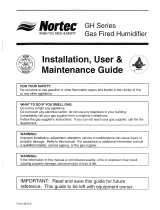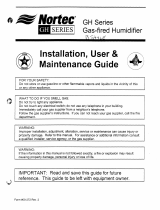Page is loading ...

Pneumatic Control Manual 717.1
Temperature Section
Technical Bulletin T-3102
Issue Date 0882
© 1982 Johnson Controls, Inc. 1
Code No. LIT-7171160X
T-3102 Heating-Cooling Deadband Thermostat
Installation and Calibration
The T-3102 is a low volume
output thermostat designed to
modulate heating and cooling
controlled devices in response to
temperature changes.
Mounting
The T-3102 can be mounted in
any position on a relatively
vibration-free surface. The
supply line must be connected to
the restricted branch of the
1/4 in. barbed tee fitting.
If a T-275-100 bulb element
holder is used to mount the
element: locate the sensitive
portion of the element in a
representative area of the air
sampling chamber. Slide the
rubber grommet on the holder
over the element past the sensing
portion. Crimp the holder slightly
to hold the element and attach
the holder to the nearest hanger.
Calibration
The T-3102 is calibrated for
4-1/2 psig and 11 psig output at
the heating and cooling set
points, respectively. This
matches the mid spring range of
typical 3 to 6 psig and 9 to
13 psig heating and cooling
valves. The 7-1/2 PSI deadband
setting falls between the spring
ranges of the two valves.
Note:
On deadband
applications which have
overlapping spring ranges, a
C-9200 or other sequencing
device should be used to bias
the cooling valve spring range to
compensate for spring range
shift.
When making calibration
changes on the T-3102, always
perform the adjustments in the
following order:
1. Deadband Adjustment
2. Cooling Set Point
3. Heating Set Point
Fig. 3: Factory Calibration Graph
Fig. 2: Bulb Element Mounting

2 T-3102 Technical Bulletin
Deadband Adjustment
1. Insert an X-200-140
hypodermic test probe with
gage into the test
connection.
2. Be sure that the temperature
at the element is above 67F.
At this point, the cooling lid is
unseated and the heating lid
is seated. If the temperature
at the element is below 67F,
the heating lid will be
unseated and inaccurate
gage readings will result.
3. Rotate the set point knob
counterclockwise until output
pressure remains constant at
approximately 7-1/2 psig.
Note the set point knob
readings.
4. Loosen the set point knob.
Remove the set point knob
and cover. Rotate the
deadband pressure regulator
screw until the desired
deadband pressure is
reached. Rotate clockwise
(CW) to increase or
counterclockwise (CCW) to
decrease the setting.
60° rotation equals
approximately a 1 PSI
change.
5. Replace the cover. Position
the set point knob over the
dials so that the readings
noted in Step 3 can be
viewed through the windows.
Tighten the set point knob in
place and turn the knob to
original factory setting.
Temperature Set Point
Adjustment
If the pressure settings of the
heating and cooling set point are
acceptable to the application, the
following instructions can be used
to change dial settings. If both
dial settings
and
pressure
settings must be changed, refer
to instructions entitled
“Temperature and Pressure Set
Point Adjustment”.
Changing Set Points with 10F°
Span Between Heating and
Cooling
To change set points while
maintaining a 10F° span between
heating and cooling, simply rotate
the set point knob CW to
decrease or CCW to increase the
set points. Both set points will
decrease or increase equally.
Changing Span Between Set
Points
1. Turn the set point dial to the
desired cooling set point.
2. Loosen the set point knob.
Remove the set point knob
and cover.
Fig. 5: T-3102 with Set Point Knob Removed

T-3102 Technical Bulletin 3
3. Rotate the heating set point
screw CW to decrease or
CCW to increase the heating
set point. Each increment
represents a 1F° change.
4. To make the set point knob
indicate the new settings,
loosen the dial set screw on
the set point dials.
5. Rotate the top (heating) dial
the same number of
increments and in the same
direction as in Step 3 above.
Tighten the set screw.
6. Replace the cover. Position
the set point knob so that the
desired heating and cooling
set points can be viewed
through the windows.
Tighten the set point knob in
place.
Temperature and Pressure
Set Point Adjustment
Note: While performing this
procedure, the temperature at the
element must be within the
operating range of the instrument.
Cooling Set Point
1. Note the temperature at the
element.
2. Turn the set point knob to the
cooling set point that matches
the temperature in Step 1.
3. Loosen and remove the set
point knob.
4. Turn the cooling output
adjusting screw to reach and
output pressure equal to the
mid spring range of the
cooling valve. Note: The
cooling output adjusting screw
is inside the post.
5. Position the set point knob so
that the temperature at the
element can be viewed
through the cooling set point
window. Tighten the set point
knob in place and turn to the
desired cooling set point.
Heating Set Point
6. With a pencil, make a mark
on the cover next to the
heating set point window.
This mark will be used later in
the procedure to reposition
the heating dial.
7. Loosen the set point knob.
Remove the set point knob
and cover. Turn the heating
adjusting screw to reach an
output equal to the mid spring
range of the heating valve.
The heating set point is now
controlling at the ambient
temperature.
8. Turn the heating adjusting
screw to the desired heating
set point. Each increment
equal 1F°. CW rotation
decreases the setting and
CCW rotation increases the
setting. Replace the cover.
9. Loosen the dial set screw
and move the top (heating)
dial to the new set point. The
new set point should be
positioned where the original
set point from Step 6 was
positioned. Tighten the dial
set screw.
10. Replace the set point knob.
The new set points can now
be viewed in the windows of
the set point knob.
Operational Checkout
1. Note the settings on the set
point knob.
2. Turn the set point knob all
the way CW. Output
pressure should rise to within
1 PSI of supply pressure.
3. Turn the set point knob all
the way CCW. Output
pressure should drop below
3 psig.
4. Turn the set point knob to the
position noted in Step 1
above. Remove the test
probe.
Repair Information
If the T-3102 fails to operate
within its specifications, and
attempts to calibrate the
instrument fail, refer to
Repair Parts R-T-3102-2 for
the appropriate repair parts.

4 T-3102 Technical Bulletin
Notes
Controls Group
507 E. Michigan Street
P.O. Box 423 Printed in U.S.A.
Milwaukee, WI 53202
/


